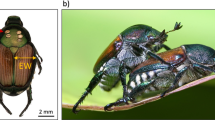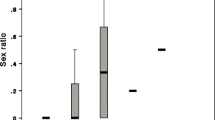Summary
When the phoretic mite Poecilochirus carabi reproduces in the brood chamber of its carrier Necrophorus vespilloides, a beetle with biparental brood care, the first deuteronymphs of the new mite generation aggregate on the male beetle. They do not use sex-specific traits to discriminate between male and female beetles in the brood chamber, but traits that are related to the beetles' behaviour and may be displayed by both parent beetles. When the male beetle departs, it carries virtually all deuteronymphs then present in the brood chamber. Deuteronymphs that develop later congregate on the female, which leaves the crypt some days after the male. Only those deuteronymphs that miss the female's departure disperse on the beetle larvae, meaning they have to wait in their pupal chambers until the beetles have completed their development. On average, 86% of the deuteronymphs leave the brood chamber on the parent beetles, thereby gaining the advantage of an early departure. As soon as their carrier arrives at one of the beetles' meeting places, the deuteronymphs can transfer between the beetles present. Choice experiments revealed that the deuteronymphs tend to even out density differences between congregating carriers, and prefer sexually mature to immature beetles. Therefore, transferring between beetles results in a dispersion of deuteronymphs on the sexually mature beetles of the population.
Similar content being viewed by others
References
Athias-Binche F (1990) Sur le concept de symbiose. L'exemple de la phorésie chez les acariens et son évolution vers la parasitisme ou le mutualisme. Bull Soc Zool Fr 115:77–98
Bartlett J (1988) Male mating success and paternal care in Nicrophorus vespilloides (Coleoptera: Silphidae). Behav Ecol Sociobiol 23:297–303
Binns ES (1982) Phoresy as migration—Some functional aspects of phoresy in mites. Biol Rev 57:571–620
Christie JE (1983) A new species of Alliphis (Mesostigmata: Eviphididae) from Britain. Acarologia 24:231–242
Costa M (1969) The association between mesostigmatic mites and coprid beetles. Acarologia 11:411–428
Hunter PE, Rosario RMT (1988) Associations of mesostigmata with other arthropods. Annu Rev Entomol 33:393–417
Hyatt KH (1980) Mites of the subfamily Parasitinae (Mesostigmata: Parasitidae) in the British Isles. Bull Brit Mus Nat Hist Zool 38:237–378
Hyatt KH, Emberson RM (1988) A review of the Macrochelidae (Acari: Mesostigmata) of the British Isles. Bull Br Mus Nat Hist Zool 54:63–125
Karg W (1971) Die freilebenden Gamasina (Gamasides), Raubmilben. In: Dahl M, Peus F (eds) Die Tierwelt Deutschlands und der angrenzenden Meeresteile nach ihren Merkmalen und nach ihrer Lebensweise. Gustav Fischer Verlag, Jena
Karg W (1989) Uropodina Kramer, Schildkrötenmilben. In: Senglaub K, Hannemann HJ, Schumann H (eds) Die Tierwelt Deutschlands und der angrenzenden Meeresteile nach ihren Merkmalen und nach ihrer Lebensweise. Gustav Fischer Verlag, Jena
Korn W (1982) Zur Fortpflanzung von Poecilochirus carabi G. u. R. Canestrini 1882 (syn. P. necrophori Vitzt.) und P. austroasiaticus Vitzthum 1930 (Gamasina, Eugamasidae). Spixiana (Muench) 5:261–288
Korn W (1983) Zur Vergesellschaftung der Gamasidenarten Poecilochirus carabi G. u. R. Canestrini 1882 (=P. necrophori Vitzthum 1930), P. austroasiaticus Vitzthum 1930 und P. subterraneus Müller 1859 mit Aaskäfern aus der Familie der Silphidae. Spixiana (Muench) 6:251–279
Lengerken H von (1954) Die Brutfürsorge-und Brutpflegeinstinkte der Käfer. Akademische Verlagsgesellschaft, Leipzig
Lindquist EE (1975) Associations between mites and other arthropods in forest floor habitats. Can Entomol 107:425–437
Müller JK, Eggert AK (1987) Effects of carrion-independent pheromone emission by male burying beetles (Silphidae: Necrophorus). Ethology 76:297–304
Müller JK, Eggert AK (1988) Biologie und Fortpflanzungsverhalten des Totengräbers Necrophorus vespilloides. Sitzungsber Ges Naturforsch Freunde Berl N F 28:31–43
Müller JK, Eggert AK, Dressel J (1990) Intraspecific brood parasitism in the burying beetle Necrophorus vespilloides (Coleoptera: Silphidae). Anim Behav 40:491–499
Müller JK, Schwarz HH (1990) Differences in carrier-preference and evidence of reproductive isolation between mites of Poecilochirus carabi (Acari, Parasitidae) living phoretically on two sympatric Necrophorus species (Coleoptera, Silphidae). Zool Jahrb Abt Syst Oekol Geogr Tiere 117:23–30
Neumann KW (1943) Die Lebensgeschichte der Käfermilbe Poecilochirus necrophori Vitzth. nebst Beschreibung aller Entwicklungsstufen. Zool Anz 142:1–21
Otronen M (1988) The effect of body size on the outcome of fights in burying beetles (Nicrophorus). Ann Zool Fenn 25:191–201
Pukowski E (1933) Ökologische Untersuchungen an Necrophorus F. Z Morphol Ökol Tiere 27:518–586
Rapp A (1959) Zur Biologie und Ethologie der Käfermilbe Parasitus coleoptratorum L. 1758 (Ein Beitrag zum Phoresie-Problem). Zool Jahrb Abt Syst Oekol Geogr Tiere 86:303–366
Scheucher R (1959) Systematik und Ökologie der deutschen Anoetinen. In: Stammer HJ (ed) Beiträge zur Systematik und Ökologie mitteleuropäischer Acarina. Akademische Verlagsgesellschaft, Leipzig
Schwarz HH, Müller JK (1990) Species characterization by ecological and genetic traits. Verh Dtsch Zool Ges 83:515–516
Schwarz HH, Müller JK, Baker A (1991) Genetic differentiation between deuteronymphs of Poecilochirus carabi (Mesostigmata, Parasitidae) living on sympatric Necrophorus species (Coleoptera, Silphidae). In: Dusbabek F, Bukva V (eds) Modern Acarology. Academia, Prague and SPB Academic, The Hague, in press
Springett BP (1968) Aspects of the relationship between burying beetles, Necrophorus spp. and the mite, Poecilochirus necrophori Vitz. J Anim Ecol 37:417–427
Starzyk JR (1967) An interesting case of phoresis of the mite Poecilochirus necrophori Vitzth. (Parasitiformes, Parasitidae) on the burying beetle Nicrophorus fossor Er. (Coleoptera, Silphidae). Przegl Zool 11:51–53
Trumbo ST (1991) Reproductive benefits and the duration of paternal care in a biparental burying beetle, Necrophorus orbicollis. Behaviour 117:82–105
Wilson DS (1982) Genetic polymorphism for carrier preference in a phoretic mite. Ann Ent Soc Am 75:293–296
Wilson DS (1983) The effect of population structure on the evolution of mutualism: a field test involving burying beetles and their phoretic mites. Am Nat 121:851–870
Wilson DS, Knollenberg WG (1984) Species packing and temperature dependent competition among burying beetles (Silphidae: Nicrophorus). Ecol Entomol 9:205–216
Wilson DS, Knollenberg WG (1987) Adaptive indirect effects: the fitness of burying beetles with and without their phoretic mites. Evol Ecol 1:139–159
Wilson DS, Knollenberg WG, Fudge J (1984) Food discrimination and ovarian development in burying beetles (Coleoptera: Silphidae: Nicrophorus). Ann Entomol Soc Am 77:165–170
Wise GU, Henessey MK, Axtell RC (1988) A new species of manureinhabiting mite in the genus Poecilochirus (Acari: Mesostigmata: Parasitidae) predacious on house fly eggs and larvae. Ann Entomol Soc Am 81:209–224
Author information
Authors and Affiliations
Rights and permissions
About this article
Cite this article
Schwarz, H.H., Müller, J.K. The dispersal behaviour of the phoretic mite Poecilochirus carabi (Mesostigmata, Parasitidae): adaptation to the breeding biology of its carrier Necrophorus vespilloides (Coleoptera, Silphidae). Oecologia 89, 487–493 (1992). https://doi.org/10.1007/BF00317154
Received:
Accepted:
Issue Date:
DOI: https://doi.org/10.1007/BF00317154




